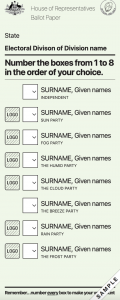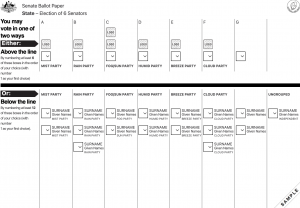Deciding who to vote for is one thing, but voting CORRECTLY is equally important.
You wouldn’t be alone in thinking all you need to do is put a 1 in the box of your preferred candidate, but did you know there are TWO ballot papers that need to be completed in order to ensure you vote is counted?
If your ballot papers are not completed correctly, your vote will not be counted and marked as an informal vote.
Below we’ll explain the two ballot papers below, show you examples of each and explain how to complete them.
You can also do a practice vote online before election day so that when you get to the polling booth, you are comfortable with what you need to do. As it is online, you can ‘submit’ your form and the website will tell you if it is correct.
House of Representative Ballot Paper (Green)
For the House of Representative Ballot Paper, you need to number all boxes from 1 through to 8. Do not leave any blank and don’t use dashes, dots or crosses. You must put a number in every box, or your vote will not be counted.
Placing a number 1 against a candidate is considered the first preference or primary vote. If no candidate secures an absolute majority of primary votes (ie more than 50%), the candidate with the fewest votes is then eliminated from the count. For this candidate, the other preferences on his or her ballot papers are redistributed to the other candidates. This continues until one candidate has 50% plus 1, at which point he or she is elected for that seat.
HOT TIP: Perhaps you know who you want to mark as number 1, but are unsure of who to number 2-8. Check what order your first choice recommends – often they will share their preferred order on their social media pages.
To view or practice the House of Representatives Ballot Paper click here.
Senate Paper (White)
There are 76 senators in the upper house: 12 from each of the six states, and two each from the two mainland territories (the Australian Capital Territory and the Northern Territory).
The senators from the states are elected for six years, and those from the territories are elected roughly every three years along with the House of Representatives. Therefore half of the Senate is up for re-election every three years.
You can vote for your state or territory’s senators in one of two ways:
Above the line: Simply put a 1 in the box of the party you support, and that party will decide all your other preference votes for you.
Below the line: Number all the candidates in order (as with your vote for the House of Representatives). You must put a number in every box, or your vote will not be counted.
Once a candidate has reached 14.3% of the vote (33% in the territories), he or she is elected. At that point, a complex system comes into play to redistribute their other ballot papers.
To view or practice the Senate Paper, click here.
Information used in this article was taken from AEC, SBS and The Guardian Australia.
















